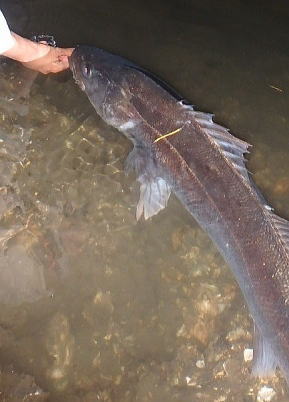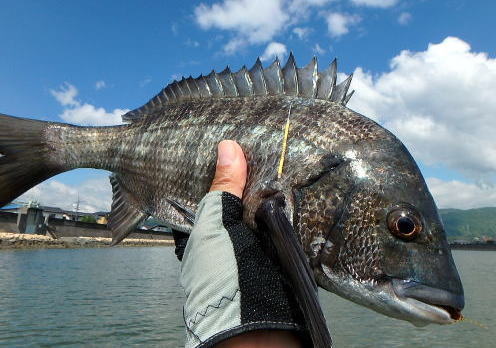Once back home, report the catch. On JGFA web page there is a form where
you can fill out with details of the catch, including dates, location and
the length.
If the fish is caught again, the re-catch report can be filed (can be done
by anyone, also by non-membersl) through IGFA's re-catch report, where, data can be tracked and matched by the tag numbers and you can
compare the status of the fish between the first & second catch.
Next you measure the length of the fish. In case of JGFA, measurment is
not by the entire length including the tip of the tail, but to the shortest
point of the tail fin - particularly important for fish with forked tail.
All done. Memorize the tag number and release the fish.
The more knowledge and experience you gain, you come to terms with a realization
how vulnerable fish resources are. There may be large quantity of small
fish, but the number of adult fish that can reproduce, and those trophy
fish that inspire our heart are frightfully small.
Take seabass, one of the most familiar gamefish in Japan for instance.
They grow fairly fast like 4inches per year and reaches the length of 20''
at the age of 4-5. But the growth rate slows down, needing another 4-5
years to hit 30'', A trophy fish of 35'' must be around 13yrs old!
T&R is one of the actions we can exercise, to gain better understanding
of the precious resources on which our passion depend, and also to share
the knowledge with other anglers and, in a broader term if I may, with
all human beings sharing the same water.
- Back

To participate their T&R program, one has to join JGFA. They offer
several different classes of membership, with the most affordable one called
''Support member'', for 1,000yen a year. With that you can purchase the
tags (25pcs for 2,000yen).
Or you can choose to be a ''regular member'' for 6,000yen a year. Then
you receive tags free of charge, as well as a copy of their 'year book'
with interesting articles incl. T&R statistics.
Tagging is easier with breams and snappers, they have rather hard scales
but thanks to which, their bodies are firm. Also their bodies are flatter
so easier to pierce through from one side to another - best way to secure
the tag and least stressful for the fish.
On the other hand seabass and trout have more roundish body and their bodies
are slimy. We have to take care not to plant the tag too deep into the
body core.
Once you have the tags, you then need a 'tag gun' - place the pointer on
the picture above. This can be purchased from JGFA, or at DIY shops around.
It is advisable to practice shooting the gun before leaving home. There's
no denying tagging is yet another process before releasing the fish, and
the speedier you handle it, the less stress for the fish.
I presume most of the people who visit my site are anglers of conservation
mind, practicing 'C&R' already. It is always with great satisfaction
that we see off the fish that has given a special moment to us, swims away
in a healthy condition.
I wanted to know how the fish would continue their lives - how they grow
and where they go, coping with their reproductive cycle or seasonal movement.
One of the most practical ways to do that is Tag & Release.
T&R is widely practiced by game fishermen and academic researchers
across the world, and in Japan, it is supervised by JGFA - Japan Game Fishing Association.



